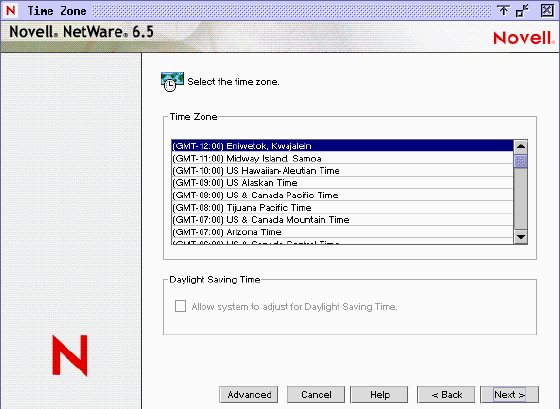4.13 Setting the Server Time Zone and Time Synchronization Method
Keeping accurate time is a critical function for servers in an eDirectory tree. The reported time must be synchronized across the network in order to provide expiration dates and time stamps to establish the order of events taking place in eDirectory.
4.13.1 Setting the Server Time Zone
-
On the Time Zone page, select the correct time zone setting from the available list.

-
Click the check box if you want the system to adjust automatically for daylight saving time.
By default, the NetWare installation synchronizes time automatically with the first server in the tree. However, you might want to set up a different time synchronization scheme or synchronize with an external time source by using Network Time Protocol (NTP).
To change the default time synchronization settings, continue with the time synchronization configuration instructions in Section 4.13.2, Configuring Time Synchronization. Otherwise, skip to Section 4.14, Setting Up Novell eDirectory.
4.13.2 Configuring Time Synchronization
Follow these steps to select and configure the server's time synchronization method:
-
On the Time Zone page, click .
-
On the Time Synchronization page, click the radio button next to the time protocol that you want.
NetWare servers can use one of two available protocols for time synchronization: NTPv3 or Timesync. Select the protocol that best fits your network's needs.
IMPORTANT:If you are installing NetWare on a Xen virtual machine, select the Timesync method and configure it to also communicate using NTP.
-
Select to use Network Time Protocol for synchronizing time on your network. (The xntpd.nlm that provides NTP time packets is also capable of providing Timesync packets for servers that require them, such as NetWare 5.0 and 4.2 servers.)
If you select this option, further configuration might be required to fully implement your time server hierarchy. For more information, see the NW 6.5 SP8: NTP Administration Guide.
-
Select to use the legacy time synchronization mechanism built in to NetWare. (The timesync.nlm that provides Timesync packets is also capable of providing NTP packets for interoperability with other time servers.)
-
-
If you selected , click the radio button next to the time server type that you want.
NetWare distinguishes four types of time servers. Three of these provide network time: Single Reference, Reference, and Primary. All other servers are called Secondary time servers because they receive their time from the time providers.
The first NetWare server installed in a network is automatically set up as a Single Reference time server. All subsequent NetWare servers are automatically set up as Secondary time servers. This default configuration works well for most small networks. If your network requires a different time synchronization configuration, you can change the time server type. For more information, see the NW 6.5 SP8: Network Time Synchronization Administration Guide.
-
(Optional) If you do not want to accept the defaults, configure Timesync time sources by selecting the check box.
-
Type the time sources in the fields provided (up to three).
Timesync time sources can be specified in one of three different formats:
-
IP Address
-
DNS Name
-
Server Name (IPX required)
-
-
(Conditional) If your time source uses Network Time Protocol (NTP), select the check box to the right of the time source.
-
-
Click .
You are returned to the Time Zone page.
-
Click .